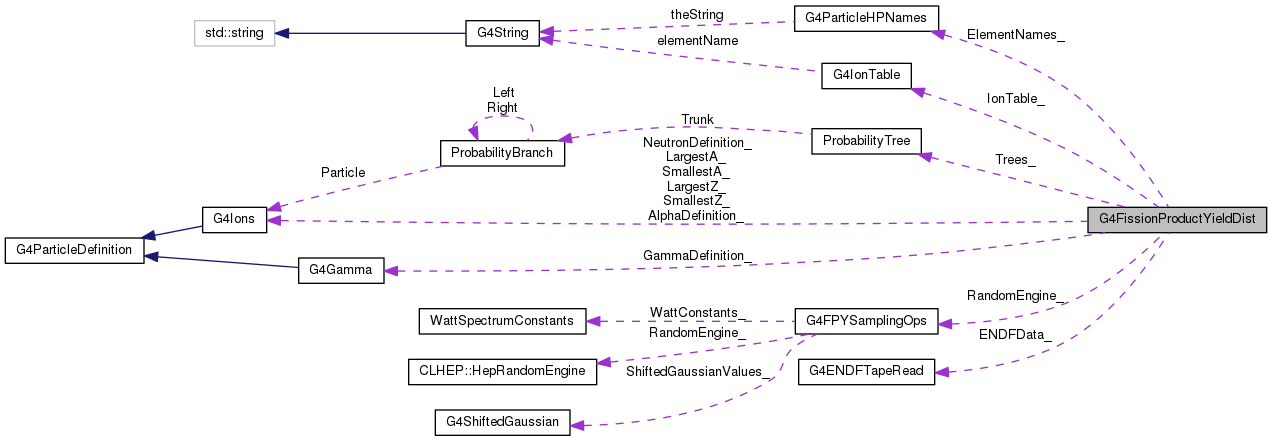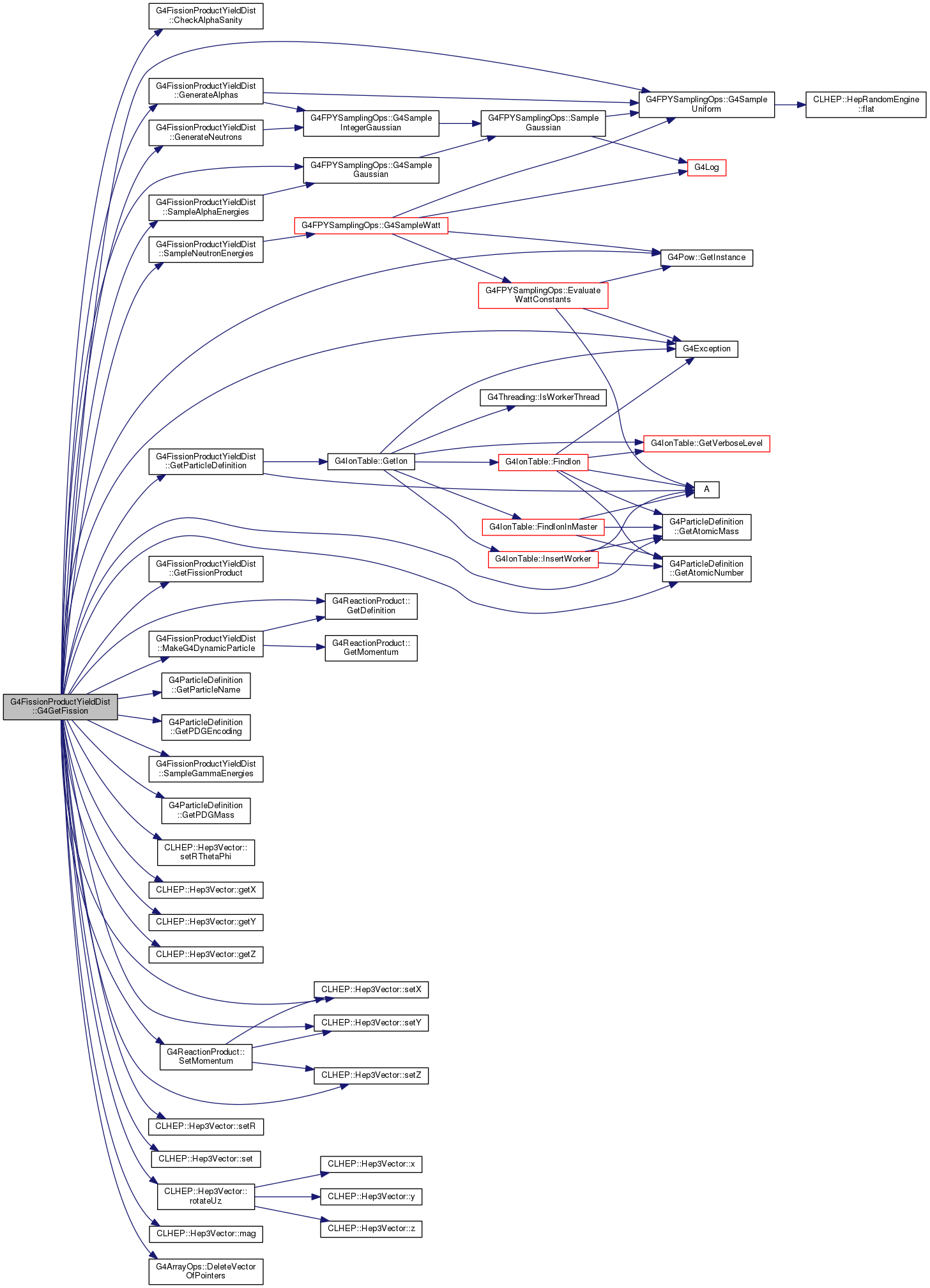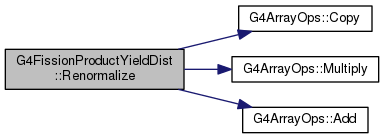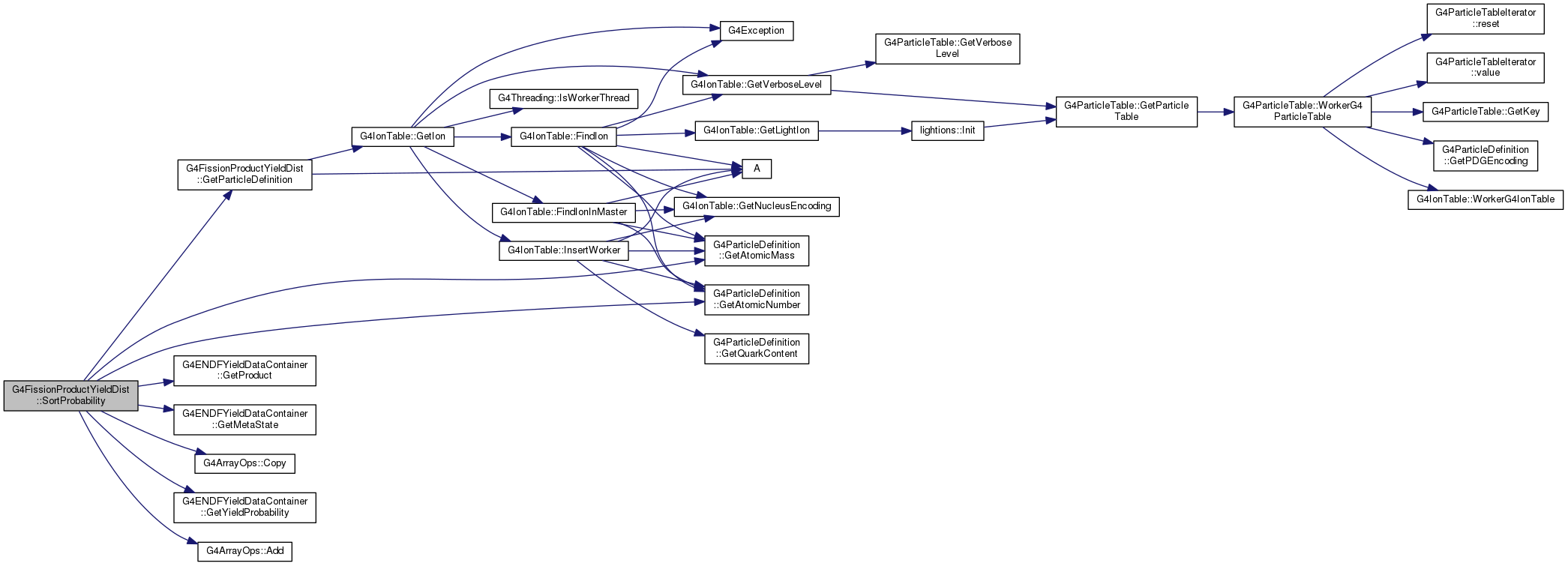|
Geant4
10.03.p01
|
|
Geant4
10.03.p01
|
#include <G4FissionProductYieldDist.hh>


Public Member Functions | |
| G4FissionProductYieldDist (G4int WhichIsotope, G4FFGEnumerations::MetaState WhichMetaState, G4FFGEnumerations::FissionCause WhichCause, G4FFGEnumerations::YieldType WhichYieldType, std::istringstream &dataStream) | |
| G4FissionProductYieldDist (G4int WhichIsotope, G4FFGEnumerations::MetaState WhichMetaState, G4FFGEnumerations::FissionCause WhichCause, G4FFGEnumerations::YieldType WhichYieldType, G4int Verbosity, std::istringstream &dataStream) | |
| G4DynamicParticleVector * | G4GetFission (void) |
| G4Ions * | G4GetFissionProduct (void) |
| void | G4SetAlphaProduction (G4double WhatAlphaProduction) |
| void | G4SetEnergy (G4double WhatIncidentEnergy) |
| void | G4SetTernaryProbability (G4double TernaryProbability) |
| void | G4SetVerbosity (G4int WhatVerbosity) |
| virtual | ~G4FissionProductYieldDist (void) |
G4FissionProductYieldDist is the base class for storing all the fission data and generating fission events.
Definition at line 54 of file G4FissionProductYieldDist.hh.
| G4FissionProductYieldDist::G4FissionProductYieldDist | ( | G4int | WhichIsotope, |
| G4FFGEnumerations::MetaState | WhichMetaState, | ||
| G4FFGEnumerations::FissionCause | WhichCause, | ||
| G4FFGEnumerations::YieldType | WhichYieldType, | ||
| std::istringstream & | dataStream | ||
| ) |
Default constructor
WhichIsotope: Isotope number of the element in ZZZAAA formWhichMetaState: GROUND_STATE, META_1, or META_2 WhichCause: SPONTANEOUS or N_INDUCED WhichYieldType: INDEPENDENT or CUMULATIVE Definition at line 83 of file G4FissionProductYieldDist.cc.
| G4FissionProductYieldDist::G4FissionProductYieldDist | ( | G4int | WhichIsotope, |
| G4FFGEnumerations::MetaState | WhichMetaState, | ||
| G4FFGEnumerations::FissionCause | WhichCause, | ||
| G4FFGEnumerations::YieldType | WhichYieldType, | ||
| G4int | Verbosity, | ||
| std::istringstream & | dataStream | ||
| ) |
Overloaded constructor
WhichIsotope: Isotope number of the element in ZZZAAA formWhichMetaState: GROUND_STATE, META_1, or META_2 WhichCause: SPONTANEOUS or N_INDUCED WhichYieldType: INDEPENDENT or CUMULATIVE Verbosity: Verbosity levelDefinition at line 110 of file G4FissionProductYieldDist.cc.
|
virtual |
Default deconstructor. It is a virtual function since G4FissionProductYieldDist is a parent class
Definition at line 1499 of file G4FissionProductYieldDist.cc.

|
protected |
Recursively burns each branch in a probability tree.
Definition at line 1525 of file G4FissionProductYieldDist.cc.

Checks to make sure that alpha overpopulation will not occur, which could result in an unsolvable zero momentum in the LAB system.
Definition at line 669 of file G4FissionProductYieldDist.cc.

Returns the G4Ions definitions pointer for the particle whose probability segment contains the (0, 1] random number RandomParticle
Definition at line 686 of file G4FissionProductYieldDist.cc.


|
protected |
Returns the G4Ions definitions pointer for the particle whose probability segment contains the (0, 1] random number RandomParticle by searching through a branch. Both the extrapolation and interpolation schemes currently use this function to identify the particle.
Definition at line 829 of file G4FissionProductYieldDist.cc.

|
protected |
Returns the G4Ions definitions pointer for the particle whose probability segment contains the (0, 1] random number RandomParticle by extrapolating values using the current data set. This function exists so that that different models of extrapolation may be more easily implemented in the future.
Definition at line 775 of file G4FissionProductYieldDist.cc.


|
protected |
Returns the G4Ions definitions pointer for the particle whose probability segment contains the (0, 1] random number RandomParticle by interpolating values in the current data set. This function exists so that that different models of interpolation may be more easily implemented in the future.
Definition at line 808 of file G4FissionProductYieldDist.cc.


| G4DynamicParticleVector * G4FissionProductYieldDist::G4GetFission | ( | void | ) |
Generates a fission event using default sampling and returns the pointer to that fission event.
Definition at line 192 of file G4FissionProductYieldDist.cc.


Selects a fission fragment at random from the probability tree and returns the G4Ions pointer.
Definition at line 609 of file G4FissionProductYieldDist.cc.


Set the alpha production behavior for fission event generation.
AlphaProduction is negative then alpha particles are sampled randomly.Definition at line 620 of file G4FissionProductYieldDist.cc.

Sets the energy of the incident particle
WhatIncidentEnergy: Kinetic energy, if any, of the incident neutron in GeVDefinition at line 630 of file G4FissionProductYieldDist.cc.

Sets the probability of ternary fission
WhatTernaryProbability: Probability of generating a ternary fission event.Definition at line 646 of file G4FissionProductYieldDist.cc.

Sets the verbosity levels
WhichVerbosity: Combination of levelsSILENT: All verbose output is repressedUPDATES: Only high-level internal changes are reportedDAUGHTER_INFO: Displays information about daughter product samplingNEUTRON_INFO: Displays information about neutron samplingGAMMA_INFO: Displays information about gamma samplingALPHA_INFO: Displays information about alpha samplingMOMENTUM_INFO: Displays information about momentum balancingEXTRAPOLATION_INTERPOLATION_INFO: Displays information about any data extrapolation or interpolation that occursDEBUG: Reports program flow as it steps through functionsPRINT_ALL: Displays any and all output Definition at line 656 of file G4FissionProductYieldDist.cc.


|
protectedvirtual |
Generates a G4DynamicParticleVector with the fission alphas
Definition at line 899 of file G4FissionProductYieldDist.cc.


|
protectedvirtual |
Generate a linked chain of neutrons and return the pointer to the last neutron in the chain.
Definition at line 937 of file G4FissionProductYieldDist.cc.


Selects a fission product from the probability tree, limited by the number of nucleons available to the system
Implemented in G4FPYBiasedLightFragmentDist, and G4FPYNormalFragmentDist.

|
protected |
Returns the G4Ions definition pointer to the isotope defined by Product and MetaState. Searches the ParticleTable for the particle defined by Product (ZZZAAA) and MetaState and returns the G4Ions pointer to that particle. If the particle does not exist then it is created in G4ParticleTable and the pointer to the new particle is returned.
Definition at line 959 of file G4FissionProductYieldDist.cc.


Generates the directory location for the data file referenced by G4FissionProductYieldDist
Definition at line 1037 of file G4FissionProductYieldDist.cc.
|
protected |
Generates the appropriate file name for the isotope requested
Definition at line 1051 of file G4FissionProductYieldDist.cc.

|
protected |
Creates a G4DynamicParticle from an existing G4ReactionProduct
Definition at line 1074 of file G4FissionProductYieldDist.cc.


|
protected |
Generates the unique name for an isotope/isomer defined by Isotope\ and MetaState in the following format: ZZZ_AAAmX_NAME
Definition at line 1085 of file G4FissionProductYieldDist.cc.


Dynamically allocates and initializes the 'field' of 'trees' with the 'trunks'
Definition at line 1118 of file G4FissionProductYieldDist.cc.

Reads in the probability data from the data file
Definition at line 1154 of file G4FissionProductYieldDist.cc.

|
protected |
Renormalizes the data in a ProbabilityTree. Traverses the tree structure and renormalizes all the probability data into probability segments, ensuring that no segment overlaps the other.
Definition at line 1187 of file G4FissionProductYieldDist.cc.


|
protected |
Sample the energy of the alpha particles. The energy used by the alpha particles is subtracted from the available energy
Definition at line 1213 of file G4FissionProductYieldDist.cc.


|
protected |
Samples the energy of the gamma rays
Definition at line 1253 of file G4FissionProductYieldDist.cc.

|
protected |
Sample the energy of the neutrons using the Watt fission spectrum. The kinetic energy consumed is returned.
Definition at line 1322 of file G4FissionProductYieldDist.cc.


Sets the nubar values for the isotope referenced by G4FissionProductYieldDistdefined from the data sets defined in SpecialOps.hh
Definition at line 1365 of file G4FissionProductYieldDist.cc.

|
protectedvirtual |
Sorts information for a potential new particle into the correct tree
Definition at line 1416 of file G4FissionProductYieldDist.cc.


|
protected |
Contains the G4Ions pointer to an alpha particle
Definition at line 187 of file G4FissionProductYieldDist.hh.
|
protected |
Controls whether alpha particles are emitted, and how many
Definition at line 189 of file G4FissionProductYieldDist.hh.
|
protected |
A run-time counter for the total number of branches stored
Definition at line 243 of file G4FissionProductYieldDist.hh.
|
protected |
The cause of fission: SPONTANEOUS or N_INDUCED.
Definition at line 175 of file G4FissionProductYieldDist.hh.
|
protected |
A running total of all the probabilities
Definition at line 239 of file G4FissionProductYieldDist.hh.
|
protected |
Pointer to G4NeutronHPNames
Provides access to the list of element names included in Geant4
Definition at line 255 of file G4FissionProductYieldDist.hh.
|
protected |
Name of the fission yield product data file that G4FissionProductYieldDist references
Definition at line 183 of file G4FissionProductYieldDist.hh.
|
protected |
Contains the g4ParticleDefinition pointer to a gamma particle
Definition at line 193 of file G4FissionProductYieldDist.hh.
|
protected |
Kinetic energy, if any, of the incident particle in GeV.
Definition at line 195 of file G4FissionProductYieldDist.hh.
|
protected |
Pointer to G4IonTable
All G4Ions are created using G4IonTable
Definition at line 251 of file G4FissionProductYieldDist.hh.
|
protected |
Number in ZZZAAA format of the isotope that G4FissionProductYieldDist references
Definition at line 168 of file G4FissionProductYieldDist.hh.
|
protected |
Defines the largest Z particle in the field of trees
Definition at line 231 of file G4FissionProductYieldDist.hh.
|
protected |
Defines the largest Z particle in the field of trees.
Definition at line 229 of file G4FissionProductYieldDist.hh.
|
protected |
Variable for ensuring that the input data is normalized
Definition at line 237 of file G4FissionProductYieldDist.hh.
|
protected |
Sets the mean gamma energy, in MeV, produced by the fission of the isotope described by Isotope_
Definition at line 199 of file G4FissionProductYieldDist.hh.
|
protected |
MetaState information of the isotope that G4FissionProductYieldDist references
Possible values are GROUND_STATE, META_1, or META_2
Definition at line 173 of file G4FissionProductYieldDist.hh.
|
protected |
Contains the G4ParticleDefinition pointer to a neutron, cast as a G4Ion for compatibility
Definition at line 202 of file G4FissionProductYieldDist.hh.
|
protected |
Nubar for the isotope and incident neutron energy that G4FissionProductYieldDist references.
Definition at line 206 of file G4FissionProductYieldDist.hh.
|
protected |
Width of the gaussian distribution that samples nubar for the isotope and incident neutron energy that G4FissionProductYieldDist references.
Definition at line 211 of file G4FissionProductYieldDist.hh.
|
protected |
Pointer to the CLHEP library random engine
Definition at line 257 of file G4FissionProductYieldDist.hh.
|
protected |
Counter for the number of nucleons available to the fission event
Definition at line 215 of file G4FissionProductYieldDist.hh.
|
protected |
Container for the energy remaining to be assigned in the fission generation
Definition at line 217 of file G4FissionProductYieldDist.hh.
|
protected |
Counter for the number of protons available to the fission event
Definition at line 213 of file G4FissionProductYieldDist.hh.
|
protected |
Defines the smallest A particle in the field of trees
Definition at line 227 of file G4FissionProductYieldDist.hh.
|
protected |
Defines the smallest Z particle in the field of trees
Definition at line 225 of file G4FissionProductYieldDist.hh.
|
protected |
Sets the ternary fission probability. Valid ranges are [0, 1]
Definition at line 191 of file G4FissionProductYieldDist.hh.
|
protected |
The number of trees in the field
Definition at line 241 of file G4FissionProductYieldDist.hh.
|
protected |
An array, or 'field', of the probability trees
Definition at line 223 of file G4FissionProductYieldDist.hh.
|
protected |
Verbosity level
Definition at line 219 of file G4FissionProductYieldDist.hh.
|
protected |
Energy values of each energy
Definition at line 235 of file G4FissionProductYieldDist.hh.
|
protected |
Number of specific energy groups
Definition at line 233 of file G4FissionProductYieldDist.hh.
|
protected |
The type of yield to be used: INDEPENDET or CUMULATIVE
Definition at line 177 of file G4FissionProductYieldDist.hh.